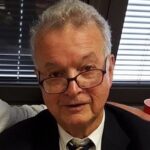Few people experience within themselves a burst of quiet illumination. It unites the cognitive, sacred, and deeply emotional realization of awareness that something entirely new and exceptionally valuable has been revealed to them. Without exception, the experience I labor to describe comes ordinarily only after a long period of disappointments, frustrations, and exhaustion of body, mind, and soul.
Friedrich August Kekulé, (1829-1896), was a German organic chemist. From the 1850s until his death, Kekulé was one of the most prominent chemists in Europe, especially in the field of theoretical chemistry.
Organic chemistry is the premedical required course most dreaded and feared by students wanting to attend medical school. Benzene is a 6-carbon structure at the very core of organic chemistry.
Kekulé acknowledged his vivid visual imagination. He dreamt of a snake eating its tail. He applied the dream to the unsolved chemical structure of benzene. Ureka! He discovered the benzene “ring,” unlocking a puzzle heretofore understood by no one and now universally accepted. Surely, Kekulé experienced the “At Last” thrill that is enduring.
Wilbur and Orville Wright “went” from their bike shop to the creators of the American Airlines Industry, with many ups and downs along the way. The Wright brothers were tinkers. Sure, they sold and repaired bicycles but their real objective was to become the first individuals to ever fly. They worked on their airplane in the back of their shop.
The fair-minded brothers flipped a coin to decide who would fly first. Wilbur won the toss but lost the first pilot contest because his flight crashed on takeoff.
“The Wright brothers’ first successful flight took place on December 17, 1903. The flight took place at Kill Devil Hills, North Carolina, where Orville Wright piloted the Wright Flyer for 12 seconds. The flight covered a distance of 120 feet and reached a top speed of 6.8 miles per hour.
“Wilbur and Orville were self-taught engineers from Dayton, Ohio who spent four years designing and testing their flying machines. The brothers chose the Kitty Hawk area for its strong winds, tall sand dunes, and wide beaches, which provided ideal conditions for flight experiments. The site of the first flight is now the Wright Brothers National Memorial.
On Orville’s 4th flight, with only a week left before Christmas, he flew over 800 feet. I was not one of the 5 witnesses but I can attest to the truth that the “At Last” experience was equally shared by the two brothers. Orville was 32 and Wilbur was 36.
The introduction of penicillin in the 1940s, which began the era of antibiotics, is recognized as one of the greatest advances in medicine.
“Antibiotics, compounds produced by bacteria and fungi, are capable of killing, or inhibiting, competing microbial species. This phenomenon has long been known; it may explain why the ancient Egyptians had the practice of applying a poultice of moldy bread to infected wounds.”
The first antibiotic (as we know them) was discovered by Alexander Fleming, Professor of Bacteriology at St. Mary’s Hospital in London in 1928. In several ways, Fleming’s story resonates with “Goldilocks and the Three Bears,” (1837). Fleming was growing strains of bacteria in petri dishes, but an unwelcomed visitor, later identified as a mold, “has been eating my germs.” It was not a ureka moment.
“Fleming (later) found that his “mold juice” was capable of killing a wide range of harmful bacteria, such as streptococcus, meningococcus and the diphtheria bacillus.
“On February 12, 1941, a 43-year-old policeman, Albert Alexander, became the first recipient of penicillin. He had scratched the side of his mouth while pruning roses and had developed a life-threatening infection with huge abscesses affecting his eyes, face, and lungs. Penicillin was injected and within days he made a remarkable recovery. But supplies of the drug ran out and he died a few days later. Better results followed with other patients though and soon there were plans to make penicillin available for British troops on the battlefield.”
The history of Penicillin, intermingled with WWII, spread the “At Last” feeling over a long list of hard working, determined, selfless people, who never gave up. Critics of “Big Pharma” (at least the overzealous ones) may benefit from history lessons in saving lives and its costs in years and efforts.
Due to a recent discovery (if you will permit such a claim) I believe I may possibly have a true “At Last” experience of my very own. Simply stated, modesty not reserved or restricted, I have discovered why Americans are angry, if not hateful. We suffer from anxious impatience. We scream aloud or internally, “I can’t stand it anymore!”
The cause of widespread anger and hateful behavior is neither racial, social issues, (though undeniably of themselves) nor political conservatism vs. liberalism.
The culprit is TV COMMERCIALS. They inevitably increase TV volume. The blast is a nerve rackingly repetitive, ill-formed, senseless messages from constipation to facial wrinkles. No one is spared.
TV evangelism is the most recently contaminated. Imagine the middle of a sermon, one finally touching the soul’s most tender point, blasted without apology, by a tasteless commercial about an unmedically approved, terribly expensive dietary supplement.
The 21st century “miracles” are packaged and sold online. It sounds like the “money changers” that annoyed Jesus into justified anger. If you want the palpable anger-hatred-anxious-frustration to end, join me in never watching, listening, or complaining about TV commercials. Turn them off. Enjoy the “At Last” experience.
Soon you will hum “Somewhere over the Rainbow Blue Birds Fly.” Peace at last in our time will be yours. You will want to love your neighbor. It’s the only way we will survive.

Robert S. Brown, MD, PHD a retired Psychiatrist, Col (Ret) U.S. Army Medical Corps devoted the last decade of his career to treating soldiers at Fort Lee redeploying from combat. He was a Clinical Professor of Psychiatry and Professor of Education at UVA. His renowned Mental Health course taught the value of exercise for a sound mind.
